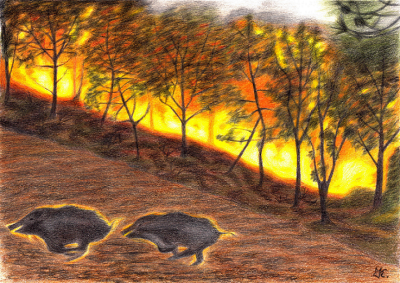meta data for this page
11.B - Forest Fires
Short Description
| Method | AD | EF | Key Category |
|---|---|---|---|
| CS, T2, T1 | CS | D | not included in key category analysis |
Country specifics
Category 11.B – Forest fires
In Germany’s forests prescribed burning is not applied. Therefore, all forest fires are categorized as wildfires (include emissions from forest fires occurring naturally or caused by humans). - Note that emissions reported here are not accounted for the national totals.
Methodology
For calculating the emissions of wildfires a country specific Tier2 approach was used. The mass of carbon emitted M(C) was calculated using the adapted equation follows the methodology of Seiler and Crutzen (1980) 1).

M(C) = 0.45 * A * B * β
where:
0.45 = average fraction of carbon in fuel wood;
A = forest area burnt in [m²];
B = mean above-ground biomass of fuel material per unit area in [kg/m²];
β = burning efficiency (fraction burnt) of the above-ground biomass.
The data on forest areas burnt for the period 1990 to 2020 have been taken from the German forest fire statistic (BLE, 2021)2) managed by the Federal Agency for Agriculture and Food. The mean above-ground biomass was derived for each year by linear extrapolation and interpolation between the
- German National Forest Inventorys of 1987, 2002, 2012 (Bundeswaldinventuren 1987, 2002, 2012),
Pursuant to König (2007) 3), 80% of the forest fires in Germany are surface fires and 20% crown fires. In accordance to the IPCC Good Practice Guidance for LULUCF (2003) a burning efficiency of 0.15 was used for surface fires and an efficiency of 0.45 was used for crown fires.
The emissions for the pollutants were calculated by multiplying the mass of carbon with the respective emission factors from table 3-3 (EMEP/EEA, 2019)4).
For the calculation of particulate emissions (TSP, PM10 and PM2.5) the burnt biomass was multiplied with the respective emission factors from table 3-5 (EMEP/EEA, 2019). Those particulate emission factors have been estimated by averaging the emission factors from the US Environmental Protection Agency (USEPA, 1996) 5) methodology, since no better information is available. Those emission factors are assumed to be the same for all types of forest.
The Guidebook does not indicate whether EFs have considered the condensable component (with or without).
Activity data
The data on forest areas burnt for the period 1990 to 2020 are based on the German forest fire statistic (BLE, 2021) managed by the Federal Agency for Agriculture and Food.
Table 1: Area of forest burnt from 1990 until the latest reporting year, in [ha]
| 1990 | 1991 | 1992 | 1993 | 1994 | 1995 | 1996 | 1997 | 1998 | 1999 |
|---|---|---|---|---|---|---|---|---|---|
| 1,606 | 920 | 4,908 | 1,493 | 1,114 | 592 | 1,381 | 599 | 397 | 415 |
| 2000 | 2001 | 2002 | 2003 | 2004 | 2005 | 2006 | 2007 | 2008 | 2009 |
| 581 | 122 | 122 | 1,315 | 274 | 183 | 482 | 256 | 539 | 757 |
| 2010 | 2011 | 2012 | 2013 | 2014 | 2015 | 2016 | 2017 | 2018 | 2019 |
| 522 | 214 | 269 | 199 | 120 | 526 | 283 | 395 | 2,349 | 2,711 |
| 2020 | |||||||||
| 368 |
Emission factors
For the year 2020 the following estimated emission factors were applied:
Table 2: Emission factors applied for 2020, in [kg/ha forest area burnt]
| EF2020 | |
|---|---|
| NOx | 125.96 |
| CO | 4,492.47 |
| NMVOC | 396.8 |
| SOx | 30.23 |
| NH3 | 34.01 |
| TSP | 713.76 |
| PM10 | 461.84 |
| PM2.5 | 377.87 |
| BC | 34.01 |
In addition, a large-scale fire, which occurred in September 2018, is reported under 11.B. A detailed description can be found in the NIR 2020 in Chapter 6.8.2.5 6), because a large amount of CO2 emissions were released.
The burned area of the drained moor, which is used as a military facility, covered 1,221 ha. This fire was extensively investigated and documented by the Federal Office for Infrastructure, Environmental Protection and Services of the German Armed Forces. The emissions are calculated according to IPCC GL (2006), chapter 2, form 2.27 7).
The product MB × Cf is set to 336 t d.m. ha-1 according to Table 2.6 and equation 2.7, 2013 IPCC Wetlands Supplement 8), i.e. it is assumed that the moor was completely drained during the fire.
- MB = mass of fuel available for combustion, tonnes ha-1 (i.e. mass of dry organic soil fuel)
- Cf = combustion factor, dimensionless
For the calculation of CO emissions the EF according to Table 2.7, 2013 IPCC Wetlands Supplement 207 g (kg dm)-1, is taken into account resulting in 85 kt of CO.

